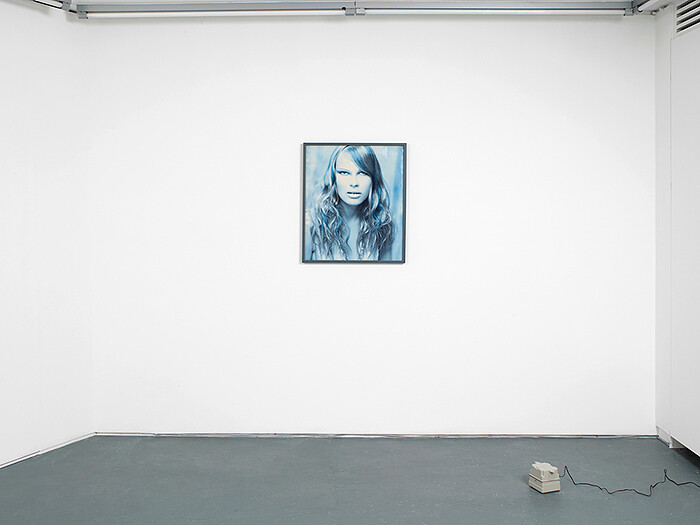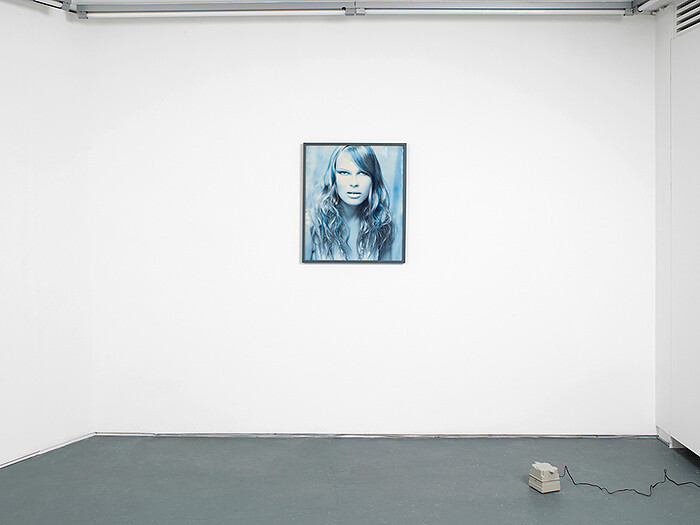These days nothing fades quicker than a trend. Who would like to be caught dead in the haircut Jennifer Aniston sported as Rachel in the 1990s television series “Friends.” Hairstyles are not meant to last, and yet some of their advertisements have found a small niche of survival in outmoded hair salons. Fading in the display windows, they enter a curiously frozen state, that is, they fade so slowly so as only to be barely recognized as fleeting leftovers from another season.
In her series “The Blues” (2012) Nina Beier presents these found advertisement photographs she discovered in salons in Denmark. Now faded to grey and left with a cold bluish tint, the photographs appear dated and futuristic at the same time. Framed behind window glass, Beier does not attempt to delay the aging progress but accepts it as something intrinsic to the nature of this type of image. Like a developing process in reverse, the images are left to grow increasingly fainter and outmoded until they will eventually disappear, just like the trends did they are sporting.
In her current show “Shirts vs Skins” at Laura Bartlett Gallery, Nina Beier stages a confrontation between the objects that we create to outlast us and the daily drama that weathers them during their lifespan. Often developed as stand-ins, these objects mirror the human in many ways, not the least in the way they age. And although their halftime might be longer than ours, they are not immune to the cruel discolorations, folds, scratches, and creases that come with time.
I guess what Beier is after could be called patina, the accumulative changes in surface texture and color that result from the use and exposure of an object over time. And yet not dissimilar from how we treat our own bodies, we also try to masquerade the aging process in the objects we surround ourselves with. We attempt to make them appear indestructible—an insurance if not stubborn resistance against our own finitude.
In her series “Fatigues” (2012), Beier attacks a selection of fabrics designed for use in the public sector. These supposedly indestructible materials were designed to be used in public transportation, in hotel lobbies or civic buildings and are meant to be fire retardant, stain resistant, and immune to vandalism. Erratic patterns and vivid colors are at the core of every style brief, with just enough pattern to deny the material any appearance of surface. Beier stretches and frames the fabrics, and then treats them with a mixture of dye, ink, stain, pigment, and bleach. The tortured remnants have lost their perky color palate and their camouflaging pattern and now hang mute and defeated in the space, emanating an almost sacral pale quiet.
Like a good old-fashioned vanitas or memento mori, Beier’s works remind us of our own mortality. At times, rather literally, for example, when she confronts us with objects such as her piece Mosquito (2012), a device that emits an ultrasonic sound that is meant to be only perceptible for the ears of people under the age of 25. Marketed as a youth deterrent, the novelty appliance doubles as a youth barometer leaving one wondering who else in the gallery can still hear it and how much longer one will be able to.
The incessant foreboding of loss accompanying the works in the show is heightened by the sight of three golf trophies that Beier’s father won when he took up the sport after becoming a pensioner. Shirts vs Skins (2012) consists of a scarcely filled vitrine, in which said trophies have been carefully placed on glass shelves. This appropriated shop vitrine reveals how private presentations of “personal” objects have been influenced by public modes of display. Further, it makes evident an internal conflict between the cheaply designed awards and their aspirational nature.
There is something melancholic about this show, something inherently sad about the intimacy of the aging objects that double as our alter egos. Beier’s show seems to exist in parallel layers, one peeking through the other, as if one could peel the aged, eroded layer away to reveal the original condition of the object on view. A condition that discloses the vanity that urges us to create something that we know will not last, ergo, nor will we.






